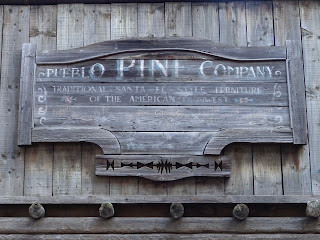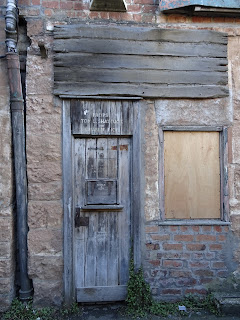There are many stories around the hills and paths of Holyrood Park and of the hills and paths leading into the park. Today, while out on a walk around Edinburgh I cut through the St Leonard’s area of town, onto St Leonard’s Hill and over to St Leonard’s Crag which runs alongside Holyrood Park. On the flat area of the crag there stands the old James Clark School, which has now been converted into flats. Long before the building was there, this was the site of a rather notorious event in the history of old Edinburgh.
The
story goes that on a warm spring day many years ago, Sunday 2 April 1600 to be
precise, St Leonard’s Crag was the site of a duel with tragic consequences for
both parties. The night before, Robert Auchmowtie,
a barber surgeon from Edinburgh, had been drinking with friends in one of the
local taverns. Also out drinking that
night with a group of friends, was James Wauchope, the son of a wealthy local
merchant. At some point during the night
Auchmowtie and Wauchope got into an argument with each other. The reason for the argument is not recorded,
but I would guess that too much alcohol and surging testosterone played quite a
big part in it. The result of the argument and the harsh words
they exchanged with each other was that Auchmowtie and Wauchope decided to
settle things the next morning with a duel at St Leonard’s Crag.
At
five the next morning Auchmowtie and Wauchope both met on St Leonard’s Crag,
each arriving with two companions to ensure fair play. The duel then commenced with swords being the
weapon of choice. The fight appears to
have quickly gone Auchmowtie’s way and within minutes he had struck Wauchope
several times to his face and head.
Bleeding heavily and mortally wounded Wauchope fell to the ground. The duel over and honour restored, Auchmowtie
and his companions left while Wauchope’s companions comforted him during his
final moments. They then carried his
body home.
The
matter did not end after the duel.
Wauchope’s father on hearing of his son’s death was understandably upset
but was also enraged, and he informed the authorities that his son had been
murdered by Auchmowtie and two accomplices.
After
some hesitation on the part of the authorities, a warrant was issued for Auchmowtie’s
arrest, and on the 23 April 1600 the City Guard arrested him for murder. At first the court was favourable towards Auchmowtie
and his version of events. They accepted
that Wauchope had been killed fairly in a duel that he had consented to take
part in. There were various
postponements of proceedings and it looked very much like the matter would be
dismissed with no trial taking place.
However, Wauchope’s relatives had friends in high places and after petitioning
King James they submitted several letters to the court from him. Firstly the king asked the court to look at
the case again, but when they didn’t move on this he wrote and ordered that Auchmowtie
be put on trial for murder and taking part in a duel without having been
granted a licence to do so (odd as it may sound now, the King, or Queen, could
grant a licence for a duel to take place, as it was seen as sometimes being a
way to end a feud and avoid a lot of unnecessary bloodshed). Auchmowtie was then tried for murder, and probably
due to the king getting involved, was found guilty. He was sentenced to death and sent to the
Tolbooth Prison to await execution.
While
imprisoned Auchmowtie, feeling hard done by and not particularly relishing the
prospect of being put to death, came up with a plan to escape. He hung a cloak outside the window of his
cell and a cloak on the inside. He told
the prison guards that he was ill and could not bear daylight. The guards accepted this without question,
though unbeknownst to them Auchmowtie had acquired some aqua fortis (nitric
acid) and was applying this to the iron bars of his cell window. Within a few days the acid had done its work and
eaten through the bars.
Auchmowtie
then put his plan to escape into action.
He summoned his apprentice and showed him the dissolved and broken bars
at the window and asked if he would go out and signal to him when the guard stationed
outside the prison had left. The boy
then willingly agreed to help him and went to wait outside and keep watch,
while Auchmowtie pulled the cloaks back slightly from the window and peered
down at him…waiting…waiting…
The
guard eventually wandered off and on seeing this the boy pulled a white
handkerchief from his pocket and waved it up to Auchmowtie, as the agreed
signal. Auchmowtie pulled the cloaks back
and lowered out a rope he had crudely constructed from his bedsheets. He then clambered through the window and
began to scramble down to freedom.
However, the guard had noticed the boy earlier and having become
suspicious had actually hidden himself so he could observe what he was up
to. On seeing Auchmowtie come out
through the prison window the guard ran back and grabbed him as he lowered
himself to the ground. He then struck
him on the head with his cudgel to subdue him and summoned other guards from
inside the prison. Auchmowtie was bound
and placed in another cell where a watch was kept over him.
Auchmowtie
languished there in despair until the day of execution arrived, when he was taken
from his cell and marched through the streets by the Town Guard to the Market
Cross (the current Mercat Cross, near to St Giles’ Cathedral, stands close to
the location of the original Market Cross).
There a platform had been constructed on which stood the Maiden (an
early form of the guillotine). In front
of a huge crowd of excited spectators, Auchmowtie was led up onto the platform
where he prayed briefly with a local minister.
He was made to kneel in front of the Maiden and place his head on the
block. An iron bar was then pulled down
over the back of his neck to stop him from pulling away or lifting his
head. Seconds later the executioner was
given a signal, the blade of the Maiden was released and RUMBLE, THUD, SPLAT, Auchmowtie
was beheaded, and the crowd let out a cheer.
And
so, my dear friends, that is the end of Auchmowtie and his story. No last
minute escapes and no happy Hollywood endings here I’m afraid.
Today,
on my walk I left a Skulferatu in the bark of an old tree at St Leonard’s Crag,
where it can watch over any more drunken duellers who stumble there to sort their
differences out with a bit of violence.
The coordinates for the location of the
Skulferatu are:
Latitude 55.943685
Longitude -3.1772880
I used the following sources for the tale of Robert Auchmowtie –
Cassels Old and New Edinburgh
– Volume 1
(pages 383-384)
By James Grant
Criminal Trials in Scotland –
Volume Second
(pages 112 to 124)
By Robert Pitcairn
1833
Digital version available from
National Library of Scotland
History of Scottish Medicine
to 1860 – Volume 1
(pages 190 to 191)
By John D Comrie
1927
Available at
https://electricscotland.com
The National Museums of
Scotland Website
.jpg)
.jpg)
.jpg)
.JPG)

.JPG)
.JPG)
.JPG)
.JPG)
.jpg)
.jpg)
.jpg)
.JPG)
.jpg)
.jpg)
.jpg)
.jpg)
.jpg)
.JPG)
.JPG)
.JPG)
.JPG)
.JPG)
.JPG)
.jpg)
.jpg)
.jpg)
.JPG)
.jpg)
















